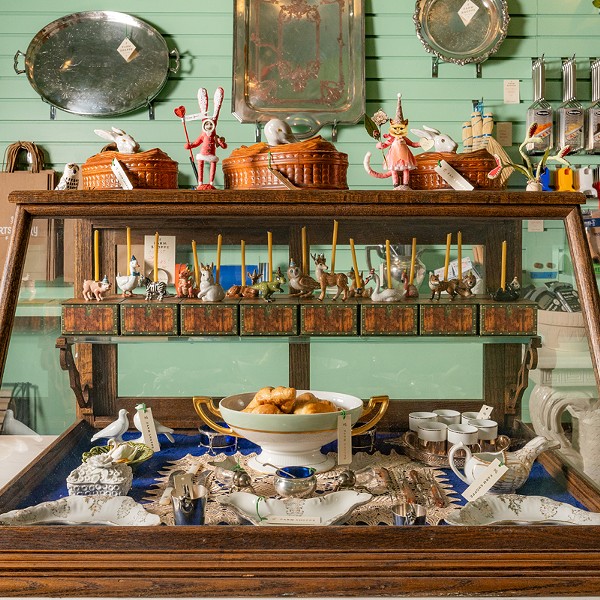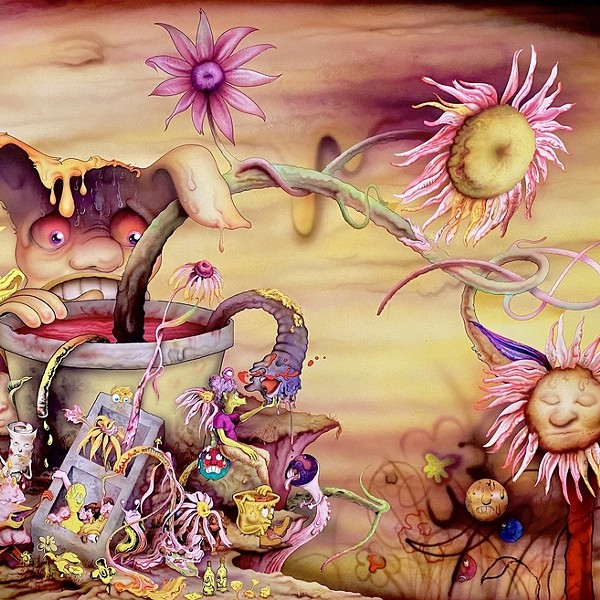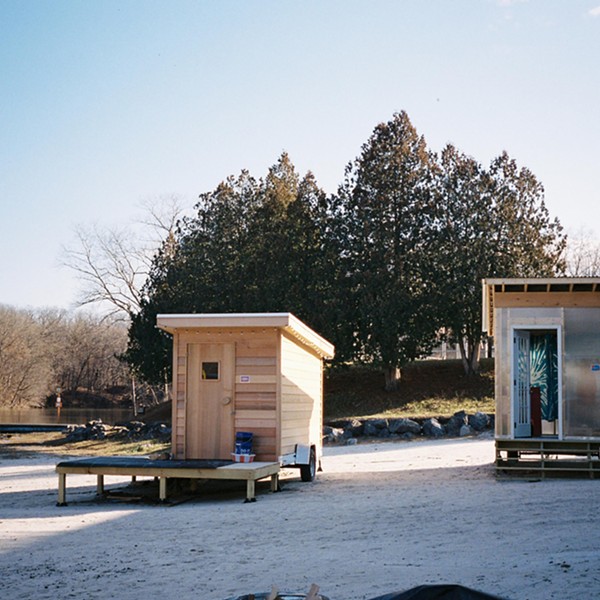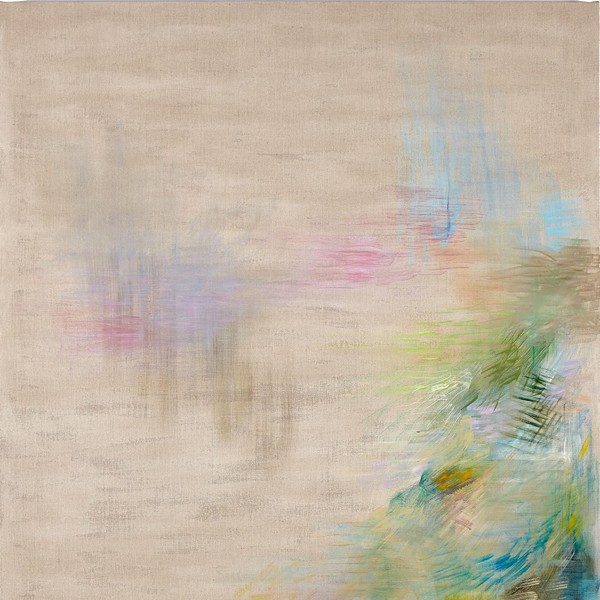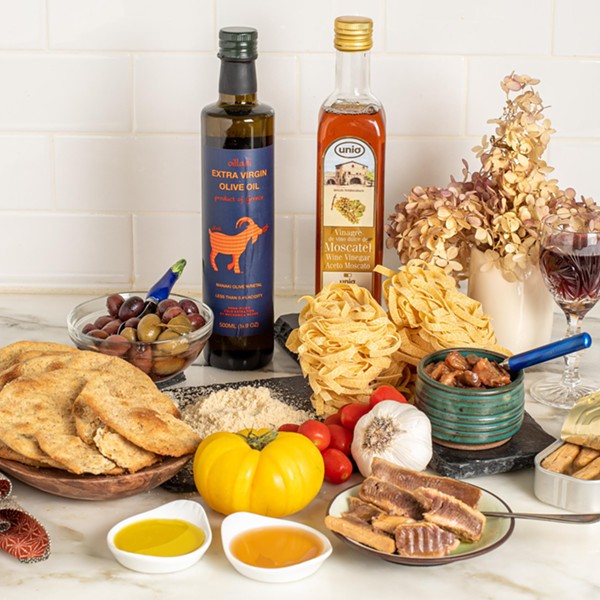
Photo by Fionn Reilly. Kris Perry stands in front of an instrument/sculpture that features a massive mounted bass drum.
Clank! Boing! Clang!
Your music editor and a handful of others are standing in a cavernous furniture factory building on the City of Hudson’s waterfront. We’re pushing buttons. We’re flipping switches. We’re operating giant machinery. Hulking, heavy apparatuses that definitely mean business. Bing! Bong! Grrrind! The din of production is loud. But we’re not making tables and chairs. We’re making music.
The imposing equipment in here was built from cast-off industrial gear by artist Kris Perry, and forms a series of motorized and pneumatically and hydraulically powered sound-producing sculptures. Besides the two of us, tonight’s crew of controllers includes singer-songwriter Elvis Perkins, performer-inventor Brian Dewan, and musicians John Rosenthal and Gideon Crevoshay. Transparently titled “Machines,” the project encompasses 15 fully operational pieces that use booming percussion, low-frequency vibration, and vacuum-blown pipes to fill the space with a sturm und drang not heard since the years when American plants were in ’round-the-clock overdrive as they cranked out tanks and battleships used to fight the Axis. There’s “The Comparator,” a waist-high cylinder originally used in a precision parts-measuring system and now outfitted with a speaker that vibrates attached bass guitar strings. “The Inspection Tank” is topped with a large, red-lit glass globe that came from a local dairy purification operation; filled with air-churned water, it uses contact mikes to amplify its bubbling sounds. “Major Tom” is comprised of three drums fashioned from propane tanks, with individual robotic beaters attached just above the drumheads. (“Two of the heads are steel, but one was too tinny,” says Perry. “So I covered it with hide from a goat that had been raised and slaughtered by a farmer friend.”) Looming supreme over the whole arsenal is one of its several unnamed members, a colossal, rust-covered burial oil tank suspended by chains from a tripod of 12-foot I-beams. With an internally mounted microphone it acts as a hanging reverb chamber, relaying the echoes of sounds piped in from outside. Obviously there’s been quite a bit of thought, sweat, time, and muscle put into these crazed retro-futuristic monoliths. What the heck inspired such ambitious madness?
“A lot of it comes from being here, in this industrial neighborhood,” Perry explains, referencing the surrounding landscape; once a busy port and manufacturing center, the majority of its massive brick structures and commercial engines have long stood silent and decaying. “This building used to be one of the biggest furniture factories in the world, the L.B. Empire company. I liked the idea of doing something that references America’s industrial past and also brings a new, whole other life into all this junk that’s just been lying around, some of it left over from more than 100 years ago. And there’s definitely a rhythm to this environment. Down here it can seem like it’s deserted and nothing’s happening anymore, but you have the trains running by every 20 or 30 minutes, ‘Clickity-clack, clickity-clack.’”
Perry, 29, comes from “a big, complicated family” in the San Francisco Bay Area, where he bounced between his textile artist mother’s home in Petaluma and his carpenter father’s place in the East Bay. “It was good in that I had this duality of environments,” recalls the artist, whose wiry frame and weathered fedora give him the look of a 1930s roustabout. “My mom’s house was in farmland, pretty much, and where my dad lived was more densely populated.” His father got him working with his hands from a young age, and his mechanical inclinations came early as well. “I’ve always been interested in finding out how things work,” he says. “I’d take my remote control cars apart and then put them back together. Even now, if I pick up a pen or something I’ll take it apart, just to see how it’s made.” At 13, these interests and one in bicycle motocross got Perry a job at a bike shop that produced high-end custom frames, where he was introduced to the art of metalworking. He entered trade school initially for electrical training (“I worked as an electrician for a while, but that was boring.”), and eventually enrolled in welding and metallurgy classes. Next came the California College of Arts, where he studied printmaking and drawing under illustrator Charles “Chuck” Pyle and focused heavily on metal sculpture. He worked at Don Rich’s famed foundry and studio in Berkely before starting his own studio, Artistic Metalworks, which specialized in assembling pieces for other artists. By 2007, though, his gears were pulling him East.

Photo by Fionn Reilly. “The Inspection Tank” is outfitted with interior contact mikes to amplify its bubbling sounds.
“I really wanted to get out of Oakland at that point, and I came out to visit some friends who run a CSA near Hudson,” Perry says. “I fell in love with the area and decided to move here. I figured the train access to New York would be good for marketing my work down there, but actually I’ve gotten more caught up in being Upstate than I’d expected.” In 2010 Perry opened his current studio, Fantastic Fabrication, in a space he shares with a vegetable fuel oil-processing business, and has since done custom work for such clients as Rensselaer Polytechnic Institute and Oberlin College. Part of what drew Perry to Hudson was its strong community of artists and galleries, a scene that also includes many musicians. And it was his interactions with the latter that, along with his studio’s location, sparked the idea for “Machines.”
“I’ve always loved music, even though I have no musical background myself whatsoever,” says Perry. “But a lot of my friends here are musicians, so I wanted to do something that would create a dialogue between what they do and what I do.” Initially, however, he was unsure about undertaking such a laborious, large-scale project. It was one of his Hudson musician friends, bassist Tommy Stinson, who encouraged him to go for it. “What Kris is doing is mixing art in several different formats together,” says Stinson, a founder of alt-rock legends the Replacements and a current member of both Guns ’N Roses and Soul Asylum. “It’s something I think is really exciting.” (Stinson was profiled in the February 2012 issue of Chronogram.)
So the wheels were in motion. To raise the considerable funds needed for the project, Perry launched a successful Kickstarter campaign and procured grants from several arts organizations and private donors. What followed were months of scouring scrap yards and auctions for components, an effort that culminated with an expedition early this year to an Ohio company specializing in marketing the disused equipment of now-closed auto plants and other factories. (It’s interesting to note that the exodus of so many older industries from the Rust Belt has given rise to another type of industry, one run by those who deal in selling off the tons of manufacturing jetsam left behind when American jobs began to go overseas in the 1980s.) As influences on “Machines” Perry cites the work of French Dadaist and Surrealist Marcel Duchamp and Swiss kinetic sculptor Jean Tinguely, as well as two San Francisco-area artists, trailblazing composer and instrument maker Harry Partch and Mark Pauline, whose industrial performance art group Survival Research Laboratories has been terrorizing the art world via its flame-shooting robots and similar “dangerous and disturbing mechanical presentations since 1979.” “I met Mark when I lived Oakland,” Perry says. “I went to shake hands with him and it startled me—I didn’t know he’d had most of his right hand blown off in a rocket fuel experiment in 1982.”
With an August 10 performance at his studio’s neighboring Basilica Hudson arts center as the target date, Perry began assembling the pieces for “Machines.” “There’s a dialogue that coincides with the machines,” explains the artist. “The project has an aesthetic that speaks to early inventions of the Industrial Revolution, but the machines themselves are made possible by the decline of industrialism from this country. I never have any preconceived designs before I go out looking for the parts, I more or less let the stuff I find inspire what it becomes.”
As he toiled to perfect his creations Perry took input from musicians, holding open jams on Tuesday nights (like the one described at the beginning of this article) to try out his work. At the early sessions the machines were accompanied with electric guitar and bass and a traditional drum kit, but those instruments were gradually phased out as more and more of Perry’s pieces took their places. Along with Stinson and the other names above, one of the long-time road-testers at the sessions has been Catskill’s Brian Dewan, an accomplished maker of offbeat instruments himself. “It’s always exciting trying to get to know and tune into the properties of any instrument, whether it’s a standardized instrument or not,” says Dewan, who was profiled in the January 2009 issue of Chronogram and with his cousin, Leon Dewan, designs, assembles, and markets the pair’s Dewanatron analog synthesizers. “I like that Kris’s machines are so minimal in what they’re built to do, it sort of forces you to be more creative when you’re playing them. Mostly they’re percussive, or about certain noises being dispatched at particular times. There are some that are more melodic, though, like the organ-like instrument he built that uses shop vacs to blow air through these thin vertical pipes. Right now, he’s making a much bigger organ using some actual church organ pipes he got from a salvage place.”
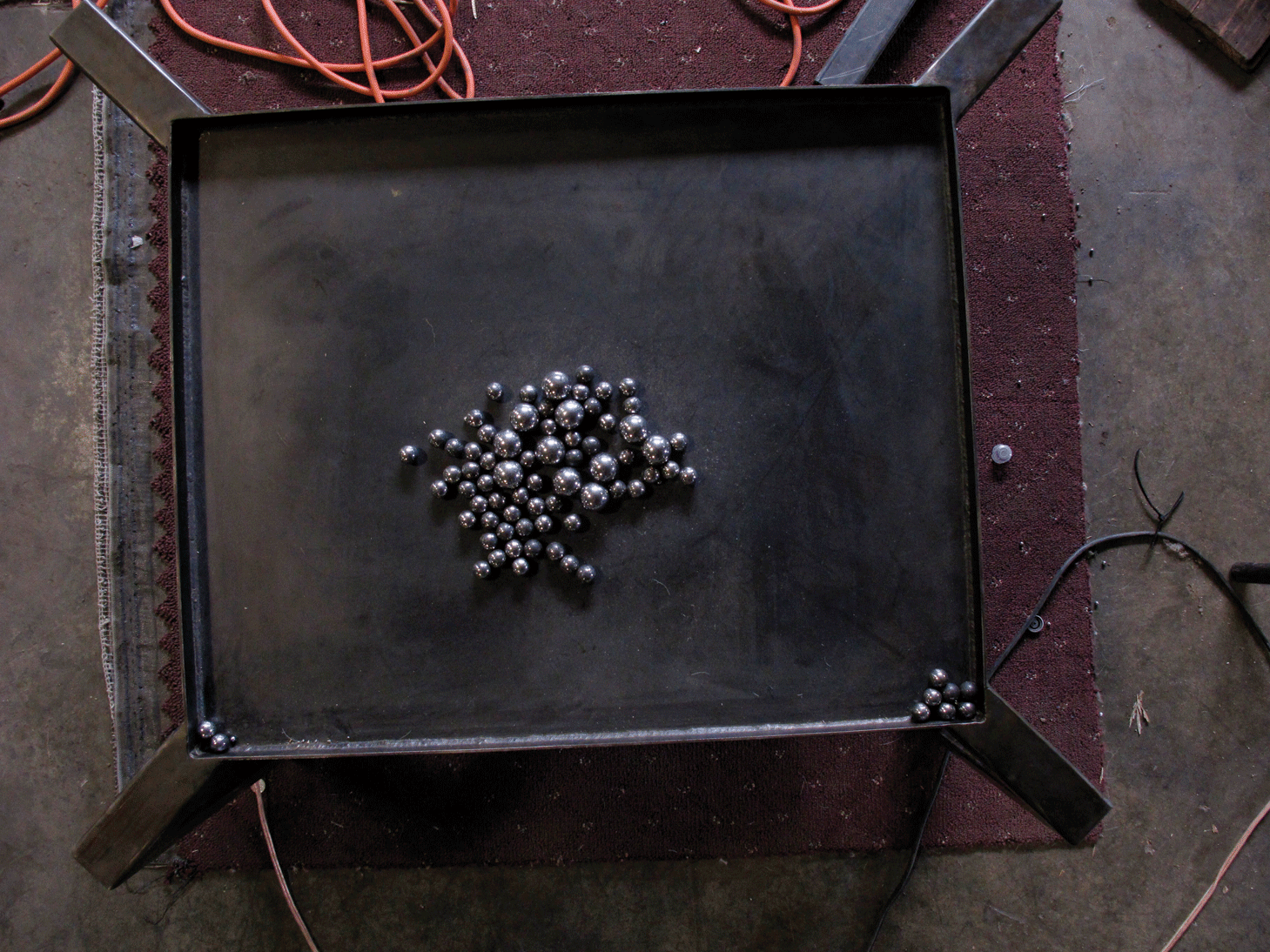
Photo by Fionn Reilly. One of Kris Perry’s unnamed “Machines,” which uses an embedded speaker to rattle loose ball bearings over its steel surface.
The Basilica performance will open “Metal Machine Music,” the first evening of the two-night Basilica Music Festival, which is being co-sponsored by indie arbiter Pitchfork magazine and will culminate with a headlining set from the acclaimed Brooklyn black metal band Liturgy. Plans include the recording of the “Machines” performance for a CD awarded to backers of the Kickstarter campaign. “[The performance] should last about an hour,” says Perry. “The [compositional] pieces we’ll be playing are about five to ten minutes each, and aren’t really defined or song-like. Generally speaking, each one is kind of loosely structured to highlight a particular machine. The whole aspect of me as a non-musician collaborating with these professional musicians has ended up creating this great exchange. I’ve gotten a bit of a feel for how music is made, and they’ve really gotten interested in metalwork. Some of the guys have come down to learn about what I do and have even helped with the fabrication.”
So what happens after the Hudson gig? The sheer logistics of taking a show of this edificial scale on the road would seem to present a problem. After all, one can’t really stuff everything in the back of a van a la your average touring band. “It’s not that easy, but it’s definitely still doable,” Perry maintains. “All I’d need is a semi, and a forklift on each end of the move. What I’d like to do is take it to other regional places for a performance and extended exhibit. I think MassMOCA [in North Adams, Massachusetts] would be the perfect venue. It’s a reappropriated factory site, so the concept of these reclaimed machines coming from old factories would fit right in there.”
But right about now it’s quittin’ time. We exit Perry’s yawning space as the five o’clock whistle blows. A train nearby answers with its own shrill whistle, as it rolls out of the station and heads down the track.
Clickity-clack, clickity-clack…
The Basilica Music Festival, in association with Pitchfork, features Kris Perry’s “Machines” followed by Liturgy and solo performances by Mick Barr, C. Lavender, and Brian Dewan and DJ sets from Rainbow in the Dark on August 10 at 9pm. Starting at 9pm on August 11, Gang Gang Dance, Prince Rama, and other acts will perform in conjunction with an afternoon DJ chillout set by Blazer S.S. and “Suggested Destination,” a visual art show with work by William Stone, Pia Dehne, Jim Krewson, and others. Tickets are $15 each night or $25 for a full weekend package. For a detailed schedule and more information, visit Basilicahudson.com.










